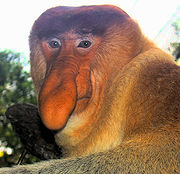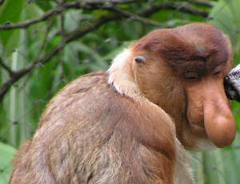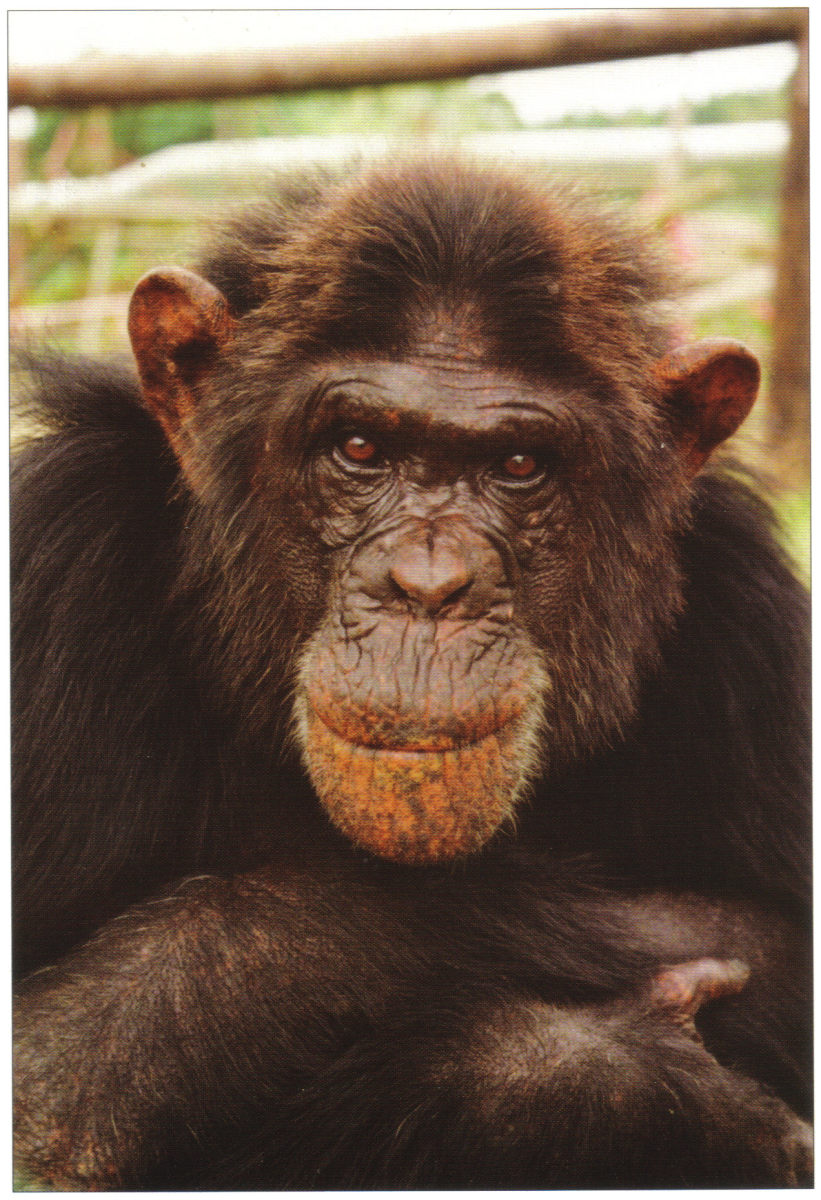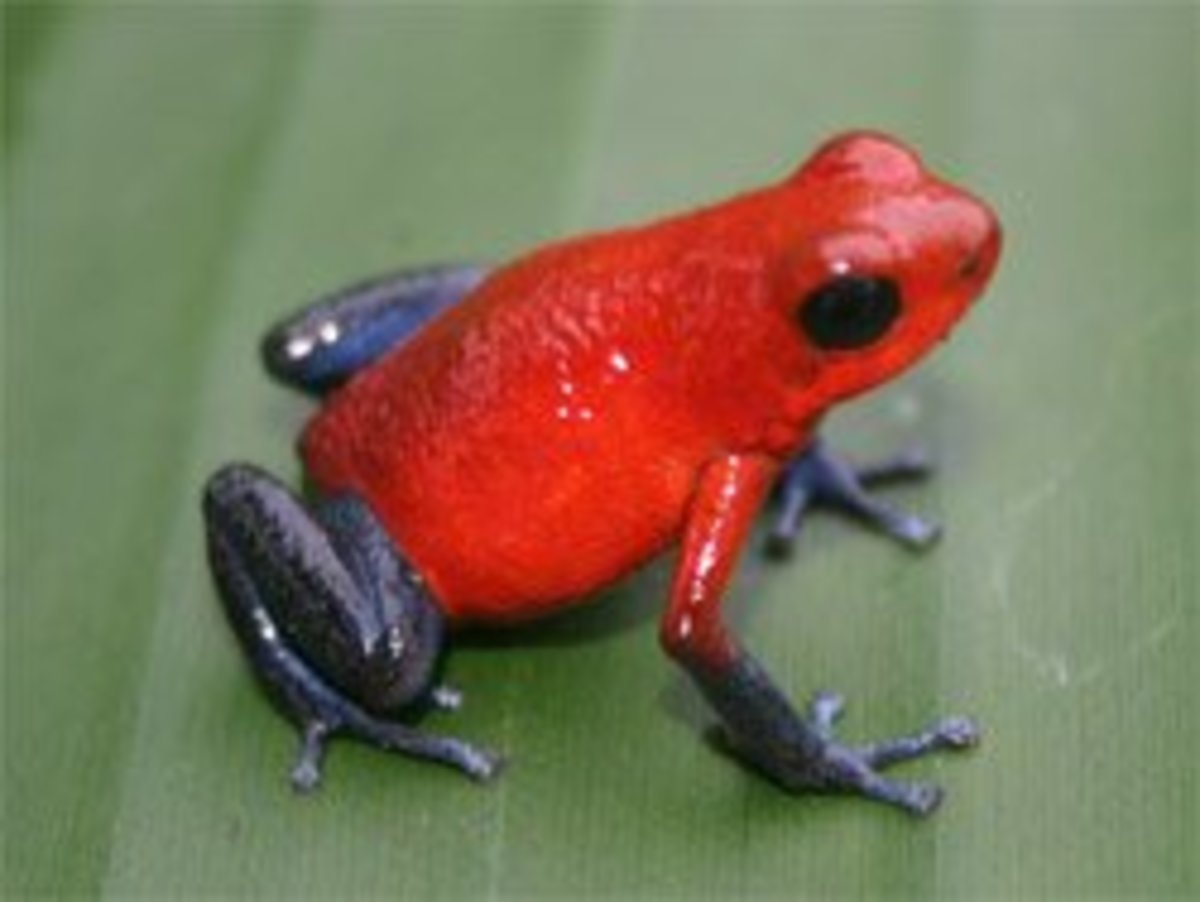Weird Animals - the Proboscis Monkey



Does the Proboscis Monkey remind you of some actor you once saw in a movie?
I am not referring to “Planet of the Apes.” Someone in a movie like Jimmy Durante or Karl Malden? Or maybe I’m the only one who sees a resemblance. Or maybe you're just too young to know those actors.
The word, “proboscis,” means long, flexible snout used for eating and generally refers to the trunk of an elephant. But the word, proboscis, has evolved to mean any nose that is extraordinarily large. This word is very appropriate for the primate also known as the Long-nosed Monkey (Nasalis larvatus).
I saw a Proboscis Monkey in the Singapore Zoo a few years ago and my first thought was this funny-looking monkey is wearing a false nose like the large pink plastic nose attached to black-framed glasses we might wear at Halloween. But no, the nose is genuine – gargantuan, immense and ridiculous looking – but nevertheless genuine.

This animal’s very large, tongue-shaped nose which may hang down over its mouth is one of its most striking appendages and is unlike any other primate nose you will ever see. This unique feature measures from four to seven inches in length and only the males possess it. The female has a much smaller, upturned nose – probably because no female monkey wants to be caught dead with such a monstrosity on the front of her face. Young monkeys have smaller upturned nostrils but their noses are still very prominent.
I refuse to be photo shopped.

These monkeys are brown to reddish brown in color with the lower parts of the body pale gray or cream-colored. The crown of fur around the top of its head resembles the hairstyle of a monk. The skin covering its face is reddish in adults, and a vivid blue in infants. They have relatively long limbs, furry feet with dark soles, and their second and third hind toes are connected by a web of skin.
The Proboscis Monkey is about two to two and one half feet long, with the tail adding about another two feet. The male can weigh from 44 to 53 pounds; females weigh less – about 22 to 25 pounds.
It is thought that the oversized nose on this male monkey may have something to do with a mating ritual. It may be a form of sexual selection with females preferring males with large noses which enhance their vocalizations.
However, the nose does more than attract potential mates; it also swells with blood when the animal is angry or upset and makes warning calls louder and much more intense than other species. These calls sound like the angry honking of a male goose.

An Indonesian nickname for this monkey is “monyet belanda” which means “Dutch monkey.” The reason: the Dutch were among the first to colonize Indonesia and many of the Dutch plantation owners were large men with large red noses and big potbellies. The proboscis monkey has a large red nose and a big belly. You get the picture.
The Proboscis Monkey with its rather large belly together with its obscenely large nose makes the animal look like a slightly besotted and past middle age dude. The large stomach is not the result of overeating but is due to the nature of its diet. Because of what these monkeys eat, their digestive system consists of compartments where bacteria digest cellulose and neutralize the toxins that they ingest from certain foods.
This unique digestive system allows them to remain in the forest canopy and feed on plants that would otherwise make them ill. Because of this unusual digestive system, the contents of the monkey’s stomach make up for a quarter of its weight! One negative however, is that these primates are not able to digest ripe fruit; therefore they eat mostly seeds, leaves, flowers, mangrove shoots and unripe fruits.

More Funny Hubs about Weird Animals
- Interview with Hippopotamus
Are hippos weird? Yes, when it pertains to mating and giving birth ... underwater! - Weird Animals - the Wooper Rooper - Axolotl
I have neoteny. It breaks up the monoteny. The axolotl (pronounced AHK-so-LA-tuhl) is a rare Mexican salamander that forever looks like a teenager. - Weird Animals - the Naked Mole Rat
- Weird Animals - the Platypus
- Weird Animals - the Star-Nosed Mole
- Weird Animals - the Blobfish
- Weird Animals - the Anglerfish
- Weird Animals - the Dung Beetle
- Weird Animals - the Aye-Aye
- Weird Animals - the Komondor
Where can you find this fascinating monkey with the grotesque nose? This primate can be found on the island of Borneo in southeast Asia where it lives in the swamps and mangroves or lowland forests. Because of the ongoing loss of their habitat as more and more mangrove swamps are being cleared, and hunting in some areas, only a few thousand are known to still exist in the wild – they are listed as endangered.
This monkey’s lifestyle is both land-based and amphibious. The Proboscis Monkey is comfortable moving through trees on dry land and also at home in shallow water where it likes to wade. When traveling in shallow water it is habitually bipedal – using an upright posture like a human.
Troops of these primates have been filmed continuing to walk upright, in single file, along forest trails when they emerged on land, with the females carrying their infants on their hip. This monkey is one of only three non-human mammals who are known to walk upright for any length of time. (The other two are gibbons and giant pangolins).
Remember the webbed hind toes I mentioned earlier? The Proboscis Monkey is an accomplished swimmer who likes to swim in deep water and often swims from island to island. Some of them have been picked up by fishing boats in the open ocean over a mile from shore. Sometimes they are kept by the fishermen as pets, but more often they are captured for their skins and their flesh which is regarded as something of a delicacy by the natives in Borneo.
Groups of these monkeys range in size from 10 to 24 individuals, usually based on a harem of one adult male and a number of adult females with their offspring. The “unattached” males live in bachelor groups. The young, with their vivid blue faces, are born singly and gestation is estimated at five to six months.
These groups occupy a home range of less than one square mile. Large troops often feed together, but individuals usually sleep alone in a tree in fairly close proximity to other troop members. Group membership is flexible and these primates are known to move from one group to another quite often.
Here’s a piece of trivia I learned while researching this article. The word,"monkey," is of unknown derivation, but it may come from the old German story of "Reynard the Fox" in which the ape's son was named "Moneke."
Do you enjoy reading about weird animals? Then please visit my other “Weird Animal” hubs.
© Copyright BJ Rakow 2011. All rights reserved.

B. J. Rakow, Ph.D., Author, “Much of What You Know about Job Search Just Ain’t So." This is a serious book about job search whch readers say is enlightening but also fun to read.








